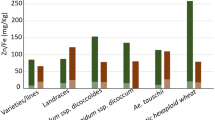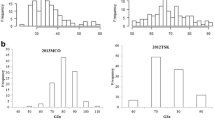Abstract
Modern durum wheat (AABB) is more sensitive to zinc (Zn) deficiency than bread wheat (AABBDD). One strategy to increase productivity and expansion of durum wheat industry in Zn-deficient soils is to improve its ability to grow and yield in such soils. This ability is termed Zn efficiency. In a growth room experiment using soil culture, we assessed the potential of Triticum turgidum L. subsp. dicoccon (Shrank) Thell. (domesticated emmer wheat, AABB) as a genetic resource for further improvement of Zn efficiency in modern durum wheat. Twenty four accessions of domesticated emmer wheat, four durum landraces/cultivars, and two bread wheat cultivars/ advanced breeders lines of known Zn efficiency were tested under Zn deficiency and Zn sufficiency. Significant variation was observed among genotypes in Zn deficiency symptoms, dry matter production, shoot Zn concentration, shoot Zn content and Zn utilisation efficiency (physiological efficiency). We identified domesticated emmer wheat accessions with greater Zn efficiency than modern durum wheat and even bread wheat genotypes. These accessions could be used in breeding programs to improve Zn efficiency of durum wheat. The results suggest that Zn efficiency of durum or bread wheat is likely to be determined collectively by its progenitors.



Similar content being viewed by others
References
Alloway BJ (2006) Zinc in soils and crop nutrition. http://www.zinccrops.org/Crops/Alloway-all.php
Anonymous (2001) Durum wheat: outlook, Bi-wkly Bull 14:20
Barker SJ, Stummer B, Gao L, Dsipain I, O’Conner PJ, Smith SE (1998) A mutant in Lycopersicon esculentum Mill. with highly reduced VA mycorrhizal colonisation: isolation and preliminary characterization. Plant J 15:791–797
Cakmak I, Ekiz H, Yilmaz A, Torun B, Koleli N, Gultekin I, Alkan A, Eker S (1997) Differential response of rye, triticale, bread and durum wheats to zinc deficiency in calcareous soils. Plant Soil 188:1–10
Cakmak I, Torun B, Erenoglu B, Ozturk L, Marschner H, Kalayci M, Ekiz H, Yilmaz A (1998) Morphological and physiological differences in the response of cereals to zinc deficiency. Euphytica 100:349–357
Cakmak I, Tolay I, Ozdemir A, Ozkan H, Ozturk L, Kling CI (1999a) Differences in zinc efficiency among and within diploid, tetraploid and hexaploid wheats. Ann Bot 84:163–171
Cakmak I, Tolay I, Ozkan H, Ozdemir A, Braun HJ (1999b) Variation in zinc efficiency among and within Aegilops species. J Plant Nutr Soil Sci 162:257–262
Cakmak O, Ozturk L, Karanlik S, Ozkan H, Kaya Z, Cakmak I (2001) Tolerance of 65 durum wheat genotypes to zinc deficiency in a calcareous soil. J Plant Nutr 24:1831–1847
Cakmak I, Torun A, Millet E, Feldman M, Fahima T, Korol A, Nevo E, Braun HJ, Ozkan H (2004) Triticum dicoccoides: An Important genetic resource for increasing zinc and iron concentration in modern cultivated wheat. Soil Sci Plant Nutr 50:1047–1054
Ekiz H, Bagci SA, Kiral AS, Eker S, Gültekin I, Alkan A, Cakmak I (1998) Effects of zinc fertilization and irrigation on grain yield and zinc concentration of various cereals grown in zinc-deficient calcareous soils. J Plant Nutr 21:2245–2256
Gao X, Zou C, Zhang F, van der Zee SEATM, Hoffland E (2005) Tolerance to zinc deficiency in rice correlates with zinc uptake and translocation. Plant Soil 278:253–261
Genc Y, McDonald GK (2004) The potential of synthetic hexaploid wheats to improve zinc efficiency in modern bread wheat. Plant Soil 262:23–32
Genc Y, McDonald GK, Graham RD (2000) Effect of seed zinc content on early growth of barley (Hordeum vulgare L.) under low and adequate soil zinc supply. Australian Journal of Agricultural Research 51:37–45
Genc Y, McDonald GK, Graham RD (2002) A soil-based method to screen for zinc efficiency in seedlings and its ability to predict yield responses to zinc. Australian Journal of Agricultural Research 53:409–421
Genc Y, McDonald GK, Graham RD (2006) Contribution of different mechanisms to zinc efficiency in bread wheat during early vegetative stage. Plant Soil 281:353–367
Graham RD (1984) Breeding for nutritional characteristics in cereals. Adv Plant Nutr 1:57–102
Graham RD, Rengel Z (1993) Genotypic variation in zinc uptake and utilization by plants. In: Robson AD (ed) Zn in soils and plants. Kluwer, Dordrecht, The Netherlands, pp 107–114
Graham RD, Ascher JS, Hynes CS (1992) Selecting for Zn-efficient cereal genotypes for soils of low zinc status. Plant Soil 146:241–250
Kalayci M, Torun B, Eker S, Aydin M, Ozturk L, Cakmak I (1999) Grain yield, zinc efficiency and zinc concentration of wheat cultivars grown in a zinc-deficient calcareous soil in field and greenhouse. Field Crops Res 63:87–98
Khabaz-Saberi H, Graham RD, Pallotta MA, Rathjen AJ, Williams KJ (2002) Genetic markers for manganese efficiency in durum wheat. Plant Breed 121:224–227
McDonald GK, Genc Y, Graham RD (2008) A simple method to evaluate genetic variation in grain zinc concentration by correcting for differences in grain yield. Plant Soil 306:49–55
Peleg Z, Saranga Y, Yazici A, Fahima T, Ozturk L, Cakmak I (2008) Grain zinc, iron and protein concentrations and zinc efficiency in wild emmer wheat under contrasting irrigation regimes. Plant Soil 306:57–67
Rengel Z (1999) Physiological mechanisms underlying differential nutrient efficiency of crop genotypes. In: Rengel Z (ed) Mineral nutrition of crops-fundamental mechanisms and implications. Food Products, New York, pp 227–265
Rengel Z, Graham RD (1995a) Importance of seed Zn content for growth on Zn-deficient soil. I. Vegetative growth. Plant Soil 173:259–266
Rengel Z, Graham RD (1995b) Importance of seed Zn content for growth on Zn-deficient soil. II. Grain yield. Plant and Soil 173:267–274
Rengel Z, Graham RD (1996) Uptake of Zn from chelate-buffered nutrient solutions by wheat genotypes differing in Zn efficiency. J Exp Bot 47:217–226
Sillanpää M (1982) Micronutrients and the nutrient status of soils: a global study. FAO Soils Bulletin No. 48, FAO, Rome
Sillanpää M (1990) Micronutrient Assessment at Country Level: An International Study. FAO Soils Bulletin No. 63, FAO, Rome
Steel RGD, Torrie JH (1960) Principles and procedures of statistics. McGraw-Hill, New York
Zarcinas BA, Cartwright B, Spouncer LR (1987) Nitric acid digestion and multi-element analysis of plant material by inductively coupled plasma spectrometry. Commun Soil Sci Plant Anal 18:131–146
Acknowledgements
We wish to thank Mrs. Teresa Fowles and Mr. Lyndon Palmer (Waite Analytical Services, The University of Adelaide) for their help with ICP-OES analysis and Dr. Hugh Wallwork (South Australian Research and Development Institute) for kindly providing the seed of emmer wheat accessions used in this study. We greatly appreciate constructive comments from the editor and anonymous reviewers. This work was supported by Grains Research and Development Corporation, Molecular Plant Breeding Cooperative Research Centre, and The University of Adelaide, Australia.
Author information
Authors and Affiliations
Corresponding author
Additional information
Responsible Editor: Ismail Cakmak.
Rights and permissions
About this article
Cite this article
Genc, Y., McDonald, G.K. Domesticated emmer wheat [T. turgidum L. subsp. dicoccon (Schrank) Thell.] as a source for improvement of zinc efficiency in durum wheat. Plant Soil 310, 67–75 (2008). https://doi.org/10.1007/s11104-008-9630-4
Received:
Accepted:
Published:
Issue Date:
DOI: https://doi.org/10.1007/s11104-008-9630-4




